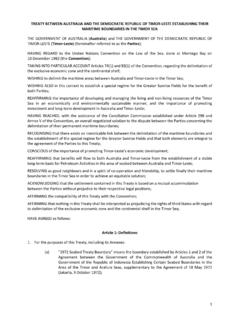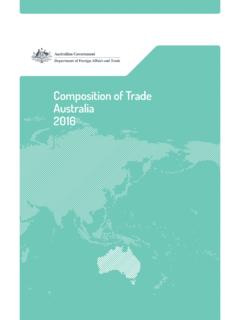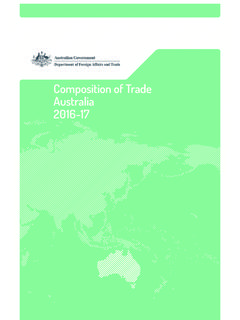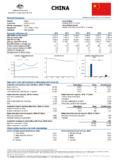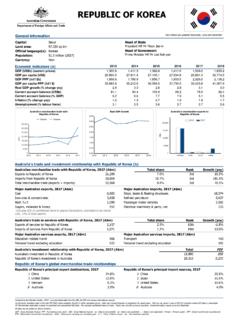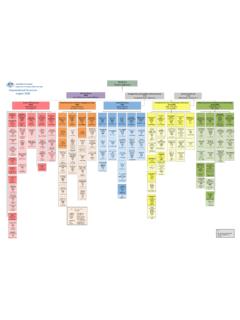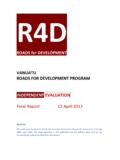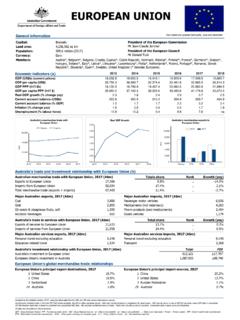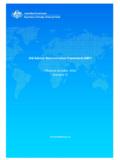Transcription of CHINA- AUSTRALIA
1 CHINA- AUSTRALIA . FREE TRADE AGREEMENT. Guide to using ChAFTA to export and import goods More information on the China- AUSTRALIA Free Trade Agreement is available at Version last updated 26 May 2016. DISCLAIMER. This document is intended to provide guidance only, and is not to be read as legal advice or similar. DFAT does not guarantee, and accepts no liability whatsoever arising from or connected to, the accuracy, reliability, currency or completeness of any material in this Guide or any linked Australian Government or other website. Users of this Guide should exercise their own skill and care with respect to the information and advice in this Guide.
2 CONTENTS. Guide to using ChAFTA to export and import goods 2. The FTA Portal online help for traders 3. Step 1: Identify the tariff classification of your goods 4. Classification 4. Advance rulings 4. Step 2: Understand how your goods will be treated under ChAFTA 5. Exporters 5. Importers 5. Applied tariffs 6. Reading the Tariff Schedule examples 6. Step 3: Determine whether your goods meet rules of origin requirements 7. Wholly Obtained (WO) Goods 7. Wholly Produced (WP) Goods produced entirely in AUSTRALIA or China 7. Product Specific Rules (PSR) For goods containing inputs from outside AUSTRALIA or China 7.
3 Other Important Rules of Origin 9. A guide to using Rules of Origin under ChAFTA 12. Step 4: Prepare origin documentation for your goods 15. Certificates of Origin 15. Declarations of Origin 15. Record keeping 15. Waiver of certification 16. Verification 16. Retrospective claims: seeking preferential rates following import 16. Contacts for further information 17. Annex 3-A Certificate of Origin 18. Declaration of Origin 21. Users of this guide should note that where reference is made to the DFAT website and FTA text and schedules, they should visit the following webpage and navigate to the relevant part of the text on the electronic version of the guide here: Guide to using ChAFTA to export and import goods _ 1.
4 GUIDE TO. USING CHAFTA. TO EXPORT. AND IMPORT. GOODS. 2 _ China- AUSTRALIA Economic Partnership Agreement The China- AUSTRALIA Free Trade Agreement (ChAFTA), which entered into force on 20 December 2015, improves AUSTRALIA 's access to our largest trading partner. AUSTRALIA is one of only a handful of developed countries to conclude a Free Trade Agreement (FTA) with China, giving our businesses a competitive advantage. ChAFTA will increase opportunities by eliminating tariffs Certify the origin of your goods to ensure you get on the vast majority of trade in goods between AUSTRALIA the lower (ChAFTA) tariff rate and China.
5 This benefits Australian businesses that export Goods seeking preferential treatment under Australian goods to China or import Chinese goods for ChAFTA must be accompanied by appropriate sale in AUSTRALIA . documentation, either a certificate of origin' or a Tariffs, or customs duties, are taxes imposed by declaration of origin'. governments on goods arriving from overseas. From the date of entry into force, more than 85 per cent (by 2015. value) of Australian exports will enter China duty free or at preferential tariff rates. This proportion will rise to 93 per FOUR STEPS TO USING CHAFTA: cent coverage by 1 January 2019 and 98 per cent once Step 1: W.
6 HAT goods am I exporting ChAFTA is fully implemented. ChAFTA has set Australian or importing? import tariffs at zero on 82 per cent of China's exports See page 4. to AUSTRALIA from day one, rising to 100 per cent tariff elimination by 1 January 2019. Step 2: HOW are these goods treated under ChAFTA? This step-by-step guide seeks to assist Australian See page 5-6. exporters and importers in taking advantage of preferential tariff treatment under ChAFTA. Step 3: WHERE are my goods produced? See page 7-14. It will help you address four key steps: Step 4: CERTIFY the origin of my goods What goods am I exporting or importing?
7 See page 15-16. Identifying the customs tariff code for your goods is a critical first step. How are these goods treated under ChAFTA? Identify the lower (preferential) duty rate for THE FTA PORTAL ONLINE HELP. your goods. FOR TRADERS. Where are my goods produced (are they To help apply this guide to your specific product, originating' goods that will qualify for lower tariffs a useful online portal is available to assist you under ChAFTA)? to make the most of the FTA with China. It is Only goods that originate' in AUSTRALIA or China recommended you read this guide first and then are eligible for preferential tariff treatment visit the portal here: under ChAFTA.
8 There are specific rules to determine eligibility. This prevents parties from other countries gaining the benefits of ChAFTA by simply transhipping their goods through AUSTRALIA or China. Guide to using ChAFTA to export and import goods _ 3. WHAT. Step 1: Identify the tariff Advance rulings classification of your goods AUSTRALIA and China are obliged to provide written advance rulings on tariff classification and origin in response to requests by importers, exporters or any person with a Determining how ChAFTA treats a particular good justifiable reason. Advance rulings are binding on the depends on correct identification of that good.
9 Importing Customs administration and give greater In ChAFTA, goods are identified by reference to an certainty, in advance of trade taking place, to businesses internationally-recognised system known as the who wish to know how their product will be treated Harmonized Commodity Description and Coding System, under ChAFTA. commonly referred to as the Harmonized System (HS). Advance rulings' can cover the HS classification The HS is a common goods classification system of more applicable to your goods and/or whether your goods than 5200 six-digit product categories (see table on are considered originating' for the purposes of ChAFTA.)
10 Page 6 for examples). (see Step 3). Typically, countries further sub-divide the six-digit HS. product categories into eight-digit or more tariff lines for For exporters greater specificity. ( AUSTRALIA and China both use eight-digit tariff codes for customs duties). Tariff codes beyond the HS Australian exporters may seek advance rulings from six-digit level are not comparable between countries. the China Customs Service. Your importer into China or your customs broker may be able to assist you with this process. Classification To find out the HS code applicable to your product, visit For importers the FTA Portal at , type in your If you are importing goods into AUSTRALIA and would like an product name, and click through to the eight or nine digit advance ruling, please contact DIBP.
